Spatial–Temporal Changes and Prediction of Carbon Storage in the Tibetan Plateau Based on PLUS-InVEST Model
Abstract
:1. Introduction
2. Materials and Methods
2.1. Study Area
2.2. Data Source and Preprocessing
2.3. Methods
2.3.1. InVEST Model
2.3.2. Dynamic Degree and Transfer Matrix
2.3.3. Patch-Generating Land Use Simulation (PLUS) Model
2.3.4. Geodetector
3. Results
3.1. Analysis of Vegetation Type Changes in the Tibetan Plateau during 2000–2020
3.2. Spatio-Temporal Variation Characteristics of Carbon Storage in the Tibetan Plateau during 2000–2020
3.2.1. Variation Characteristics of Carbon Storage
3.2.2. Spatial Variation Characteristics of Carbon Storage
3.3. Carbon Storage Prediction and Analysis of Vegetation Types in the Tibetan Plateau
3.3.1. The Analysis of Vegetation Changes under Multi-Scenario Constraints
3.3.2. The Analysis of Carbon Storage Changes under Multi-Scenario Constraints
3.4. Driving Factors of Carbon Storage Changes in the Tibetan Plateau
3.4.1. Dominant Single Factor Analysis
3.4.2. Dominant Interaction Factor Analysis
4. Discussion
4.1. The Relationship between Carbon Storage and Vegetation Types in the Tibetan Plateau
4.2. Land-Use Policy Recommendations for the Tibetan Plateau
5. Conclusions
Author Contributions
Funding
Data Availability Statement
Conflicts of Interest
Appendix A
| Vegetation Type | 2030 | 2060 |
|---|---|---|
| Montane coniferous forest | 39,952.25 | 41,845.00 |
| Hard-leaf shrub | 2802.00 | 2755.75 |
| Deciduous shrub | 5750.25 | 5022.25 |
| Mixed forest | 45,629.25 | 45,266.25 |
| Closed shrub | 91.25 | 105.25 |
| Creosote bush desert | 28,569.00 | 32,966.50 |
| Tufted dwarf grass | 60,181.75 | 67,798.00 |
| Steppe | 1,324,129.50 | 1,359,391.75 |
| Low coverage grassland | 945,921.00 | 891,580.50 |
| Non-vegetation | 88,594.25 | 94,889.25 |
| 2030 | 2060 | ||||||||||||||||||||
|---|---|---|---|---|---|---|---|---|---|---|---|---|---|---|---|---|---|---|---|---|---|
| 1 | 2 | 3 | 4 | 5 | 6 | 7 | 8 | 9 | 10 | 1 | 2 | 3 | 4 | 5 | 6 | 7 | 8 | 9 | 10 | ||
| Inertia development scenario | 1 | 1 | 0 | 1 | 1 | 0 | 1 | 1 | 1 | 0 | 1 | 1 | 0 | 1 | 1 | 0 | 1 | 1 | 1 | 0 | 1 |
| 2 | 1 | 1 | 0 | 1 | 0 | 1 | 1 | 1 | 0 | 0 | 1 | 1 | 0 | 1 | 0 | 0 | 1 | 0 | 0 | 0 | |
| 3 | 1 | 1 | 1 | 1 | 0 | 1 | 1 | 1 | 0 | 0 | 1 | 1 | 1 | 1 | 0 | 1 | 1 | 1 | 0 | 0 | |
| 4 | 1 | 1 | 1 | 1 | 0 | 1 | 1 | 1 | 0 | 0 | 1 | 1 | 1 | 1 | 0 | 0 | 1 | 1 | 0 | 0 | |
| 5 | 1 | 0 | 0 | 0 | 1 | 1 | 1 | 1 | 0 | 0 | 1 | 0 | 0 | 1 | 1 | 1 | 1 | 1 | 0 | 0 | |
| 6 | 0 | 0 | 1 | 0 | 0 | 1 | 1 | 1 | 1 | 0 | 0 | 0 | 1 | 1 | 0 | 1 | 1 | 1 | 1 | 1 | |
| 7 | 1 | 0 | 1 | 1 | 0 | 1 | 1 | 1 | 0 | 0 | 1 | 0 | 1 | 1 | 0 | 1 | 1 | 1 | 0 | 0 | |
| 8 | 0 | 0 | 0 | 0 | 0 | 1 | 1 | 1 | 1 | 1 | 0 | 0 | 0 | 0 | 0 | 1 | 1 | 1 | 1 | 1 | |
| 9 | 0 | 0 | 0 | 0 | 0 | 1 | 0 | 1 | 1 | 1 | 0 | 0 | 0 | 0 | 0 | 1 | 0 | 1 | 1 | 1 | |
| 10 | 0 | 0 | 0 | 0 | 0 | 1 | 0 | 1 | 1 | 1 | 1 | 0 | 0 | 0 | 0 | 1 | 1 | 1 | 1 | 1 | |
| Farmland protection scenario | 1 | 1 | 0 | 1 | 1 | 0 | 1 | 1 | 1 | 0 | 1 | 1 | 0 | 1 | 1 | 0 | 1 | 1 | 1 | 0 | 1 |
| 2 | 1 | 1 | 0 | 1 | 0 | 1 | 1 | 1 | 0 | 1 | 1 | 1 | 0 | 1 | 0 | 0 | 1 | 0 | 0 | 1 | |
| 3 | 1 | 1 | 1 | 1 | 0 | 1 | 1 | 1 | 0 | 1 | 1 | 1 | 1 | 1 | 0 | 1 | 1 | 1 | 0 | 1 | |
| 4 | 1 | 1 | 1 | 1 | 0 | 1 | 1 | 1 | 0 | 1 | 1 | 1 | 1 | 1 | 0 | 0 | 1 | 1 | 0 | 1 | |
| 5 | 1 | 0 | 0 | 0 | 1 | 1 | 1 | 1 | 0 | 1 | 1 | 0 | 0 | 1 | 1 | 1 | 1 | 1 | 0 | 1 | |
| 6 | 0 | 0 | 1 | 0 | 0 | 1 | 1 | 1 | 1 | 1 | 0 | 0 | 1 | 1 | 0 | 1 | 1 | 1 | 1 | 1 | |
| 7 | 1 | 0 | 1 | 1 | 0 | 1 | 1 | 1 | 0 | 1 | 1 | 0 | 1 | 1 | 0 | 1 | 1 | 1 | 0 | 1 | |
| 8 | 0 | 0 | 0 | 0 | 0 | 1 | 1 | 1 | 1 | 1 | 0 | 0 | 0 | 0 | 0 | 1 | 1 | 1 | 1 | 1 | |
| 9 | 0 | 0 | 0 | 0 | 0 | 1 | 0 | 1 | 1 | 1 | 0 | 0 | 0 | 0 | 0 | 1 | 0 | 1 | 1 | 1 | |
| 10 | 0 | 0 | 0 | 0 | 0 | 0 | 0 | 0 | 0 | 1 | 0 | 0 | 0 | 0 | 0 | 0 | 0 | 0 | 0 | 1 | |
| Ecological priority development scenario | 1 | 1 | 1 | 1 | 1 | 1 | 1 | 1 | 1 | 1 | 0 | 1 | 1 | 1 | 1 | 1 | 1 | 1 | 1 | 1 | 0 |
| 2 | 1 | 1 | 1 | 1 | 1 | 1 | 1 | 1 | 1 | 0 | 1 | 1 | 1 | 1 | 1 | 1 | 1 | 1 | 1 | 0 | |
| 3 | 1 | 1 | 1 | 1 | 1 | 1 | 1 | 1 | 1 | 0 | 1 | 1 | 1 | 1 | 1 | 1 | 1 | 1 | 1 | 0 | |
| 4 | 1 | 1 | 1 | 1 | 1 | 1 | 1 | 1 | 1 | 0 | 1 | 1 | 1 | 1 | 1 | 1 | 1 | 1 | 1 | 0 | |
| 5 | 1 | 1 | 1 | 1 | 1 | 1 | 1 | 1 | 1 | 0 | 1 | 1 | 1 | 1 | 1 | 1 | 1 | 1 | 1 | 0 | |
| 6 | 1 | 1 | 1 | 1 | 1 | 1 | 1 | 1 | 1 | 0 | 1 | 1 | 1 | 1 | 1 | 1 | 1 | 1 | 1 | 0 | |
| 7 | 1 | 1 | 1 | 1 | 1 | 1 | 1 | 1 | 1 | 0 | 1 | 1 | 1 | 1 | 1 | 1 | 1 | 1 | 1 | 0 | |
| 8 | 1 | 1 | 1 | 1 | 1 | 1 | 1 | 1 | 1 | 0 | 1 | 1 | 1 | 1 | 1 | 1 | 1 | 1 | 1 | 0 | |
| 9 | 1 | 1 | 1 | 1 | 1 | 1 | 1 | 1 | 1 | 0 | 1 | 1 | 1 | 1 | 1 | 1 | 1 | 1 | 1 | 0 | |
| 10 | 1 | 1 | 1 | 1 | 1 | 1 | 1 | 1 | 1 | 1 | 1 | 1 | 1 | 1 | 1 | 1 | 1 | 1 | 1 | 1 | |
| Vegetation Type | 2030 | 2060 | ||||
|---|---|---|---|---|---|---|
| Inertia Development Scenario | Farmland Protection Scenario | Ecological Priority Development Scenario | Inertia Development Scenario | Farmland Protection Scenario | Ecological Priority Development Scenario | |
| Montane coniferous forest | 0.66 | 0.66 | 1.00 | 0.71 | 0.71 | 1.00 |
| Hard-leaf shrub | 0.63 | 0.63 | 1.00 | 0.62 | 0.62 | 1.00 |
| Deciduous shrub | 0.52 | 0.52 | 1.00 | 0.40 | 0.40 | 1.00 |
| Mixed forest | 0.61 | 0.61 | 1.00 | 0.60 | 0.60 | 1.00 |
| Closed shrub | 0.53 | 0.53 | 1.00 | 0.67 | 0.67 | 1.00 |
| Desert shrub | 0.76 | 0.76 | 1.00 | 0.94 | 0.94 | 1.00 |
| Tufted dwarf grass | 0.57 | 0.57 | 1.00 | 0.69 | 0.69 | 1.00 |
| Steppe | 0.60 | 0.60 | 1.00 | 0.62 | 0.62 | 1.00 |
| Low-coverage grassland | 0.59 | 0.59 | 1.00 | 0.54 | 0.54 | 1.00 |
| Non-vegetation | 0.70 | 1.00 | 0.70 | 0.78 | 1.00 | 0.78 |
References
- Wang, F.; Joshua, S.; Liu, X. Carbon emission flow in the power industry and provincial CO2 emissions: Evidence from cross- provincial secondary energy trading in China. J. Clean. Prod. 2017, 159, 397–409. [Google Scholar] [CrossRef]
- Zhao, M.M.; He, Z.B.; Du, J.; Chen, L.F.; Lin, P.F.; Fang, S. Assessing the effects of ecological engineering on carbon storage by linking the CA-Markov and InVEST models. Eco. Indic. 2019, 98, 29–38. [Google Scholar] [CrossRef]
- Houghton, R.A. Revised estimates of the annual net flux of carbon to the atmosphere from changes in land use and land management 1850–2000. Tellus B Chem. Phys. Meteorol. 2003, 55, 378–390. [Google Scholar]
- Hu, Q.W.; Li, T.T.; Deng, X.; Wu, T.W.; Zhai, P.M.; Huang, D.Q.; Fan, X.W.; Zhu, Y.K.; Lin, Y.C.; Xiao, X.C.; et al. Intercomparison of global terrestrial carbon fluxes estimated by MODIS and Earth system models. Sci. Total Environ. 2022, 810, 152231. [Google Scholar] [CrossRef]
- Wang, Z.P.; He, Y.T.; Niu, B.; Wu, J.S.; Zhang, X.Z.; Zu, J.X.; Huang, K.; Li, M.; Cao, Y.A.; Zhang, Y.J.; et al. Sensitivity of terrestrial carbon cycle to changes in precipitation regimes. Eco. Indic. 2020, 113, 106223. [Google Scholar] [CrossRef]
- Guo, B.; Yang, F.; Fan, Y.W.; Zang, W.Q. The dominant driving factors of rocky desertification and their variations in typical mountainous karst areas of Southwest China in the context of global change. Catena 2023, 220, 106674. [Google Scholar] [CrossRef]
- Li, G.D.; Zhang, J.H.; Chen, C.; Tian, H.F.; Zhao, L.P. Research progress on carbon storage and flux in different terrestrial ecosystem in China under global climate change. Ecol. Environ. Sci. 2013, 22, 873–878. [Google Scholar]
- Wang, Z.H.; Liu, H.M.; Guan, Q.W.; Wang, X.J.; Hao, J.P.; Ling, N.; Shi, C. Carbon storage and density of urban forest ecosystems in Nanjing. J. Nanjing For. Univ. (Nat. Sci. Ed.) 2011, 35, 18–22. [Google Scholar]
- Yuan, N.; Wang, E.H.; Lv, S.F.; Tang, X.P.; Wang, T.Y.; Wang, G.; Zhou, Y.F.; Zhou, G.M.; Shi, Y.J.; Xu, L. Degradation reduces greenhouse gas emissions while weakening ecosystem carbon sequestration of Moso bamboo forests. Sci. Total Environ. 2023, 877, 162915. [Google Scholar] [CrossRef]
- Chuai, X.W.; Huang, X.J.; Lai, L.; Wang, W.J.; Peng, J.W.; Zhao, R.Q. Land use structure optimization based on carbon storage in several regional terrestrial ecosystems across China. Environ. Sci. Policy 2013, 25, 50–61. [Google Scholar] [CrossRef]
- Liu, X.J.; Li, X.; Liang, X.; Shi, H.; Ou, J.P. Simulating the Change of Terrestrial Carbon Storage in China Based on the FLUS-InVEST Model. Trop. Geogr. 2019, 39, 397–409. [Google Scholar]
- Liao, L.L.; Zhou, L.; Wang, S.Q.; Wang, X.Q. Carbon sequestration potential of biomass carbon pool for new afforestation in China during 2005–2013. Acta Geogr. Sin. 2016, 71, 1939–1947. [Google Scholar]
- Zhao, M.W.; Yue, T.X.; Zhao, N.; Sun, X.F.; Zhang, X.Y. Combining LPJ-GUESS and HASM to simulate the spatial distribution of forest vegetation carbon stock in China. J. Geogr. Sci. 2014, 24, 249–268. [Google Scholar] [CrossRef]
- Tao, Y.; Li, F.; Liu, X.S.; Zhao, D.; Sun, X.; Xu, L.F. Variation in ecosystem services across an urbanization gradient: A study of terrestrial carbon stocks from Changzhou, China. Ecol. Model. 2015, 318, 210–216. [Google Scholar] [CrossRef]
- Zhang, Y.; Shi, X.Y.; Tang, Q. Carbon storage assessment in the upper reaches of the Fenhe River under different land use scenarios. Acta Ecol. Sin. 2021, 41, 360–373. [Google Scholar]
- Liang, Y.; Hashimoto, S.; Liu, L. Integrated assessment of land–use/land–cover dynamics on carbon storage services in the Loess Plateau of China from 1995 to 2050. Eco. Indic. 2021, 120, 106939. [Google Scholar] [CrossRef]
- Wang, Z.; Li, X.; Mao, Y. Dynamic simulation of land use change and sassessment of carbon storage based on climate change scenarios at the city level: A case study of Bortala, China. Eco. Indic. 2022, 134, 108499. [Google Scholar] [CrossRef]
- Hou, J.K.; Chen, J.J.; Zhang, K.Q. Temporal and spatial variation characteristics of carbon storage in the source region of the Yellow River based on InVEST and GeoSoS—FLUS models and its response to different future scenarios. Environ. Sci. 2022, 43, 5253–5262. [Google Scholar]
- Javier, L.P.; Zachary, H.F.; Ivette, P.; John, V. The importance of shade trees in promoting carbon storage in the coffee agroforest systems. Agr. Ecosyst. Environ. 2023, 355, 108594. [Google Scholar]
- Tristan, R.M.B.; Renats, T.; Jeannette, E.; Cecilia, A. The effect of spatial and temporal planning scale on the trade-off between the financial value and carbon storage in production forests. Land Use Policy 2023, 127, 106583. [Google Scholar]
- Simone, R.; Laure, K.; Timothy, S. Nature-based solutions for climate change mitigation: Assessing the Scottish Public’s preferences for saltmarsh carbon storage. Ecol. Econ. 2023, 211, 107863. [Google Scholar]
- Zhang, F.T.; Su, W.C.; Liang, Y.H. A case study of ecological regionalization in Chongqing Three Gorges Reservoir area. J. Chongqing Norm. Univ. (Nat. Sci.) 2008, 25, 22–26+123. [Google Scholar]
- Tian, Y.Q.; Ou, Y.H.; Xu, X.L.; Song, M.H.; Zhou, C.P. Distribution characteristics of soil organic carbon storage and density on the Qinghai-Tibet Plateau. Acta Pedol. Sincia 2008, 45, 933–942. [Google Scholar]
- Li, R.W.; Ye, C.C.; Wang, Y.; Han, G.D.; Sun, J. Carbon storage estimation and its drivering force analysis based on InVEST model in the Qinghai-Tibetan Plateau. Acta Agrestia Ainica 2021, 29, 43–51. [Google Scholar]
- Wang, X.Y.; Ke, B.Y.; Huang, Z.Q.; Yang, G.; Huang, G.H.; Hu, Q.P.; Sun, L.L. Quantification of forest carbon storage in Qinghai-Tibetan Plateau. For. Environ. Sci. 2020, 36, 9–19. [Google Scholar]
- Guo, B.; Lu, M.; Fan, Y.W.; Wu, H.W.; Yang, Y.; Wang, C.L. A novel remote sensing monitoring index of salinization based on three dimensional feature space model and its application in the Yellow River Delta. Geoma. Nat. Haz. Risk 2023, 14, 95–156. [Google Scholar] [CrossRef]
- Li, W.; Cao, W.X.; Wang, J.L.; Li, X.L.; Xu, C.L.; Shi, S.L. Effects of grazing regime on vegetation structure, productivity, soil quality, carbon and nitrogen storage of alpine meadow on the Qinghai-Qinghai-Tibetan Plateau. Ecol. Eng. 2017, 98, 123–133. [Google Scholar] [CrossRef]
- Liu, Y.F.; Guo, B.; Lu, M.; Zang, W.Q.; Yu, T.; Chen, D.H. Quantitative distinction of the relative actions of climate change and human activities on vegetation evolution in the Yellow River Basin of China during 1981–2019. J. Arid Land 2023, 15, 91–108. [Google Scholar] [CrossRef]
- Ding, J.; Liu, X.Y.; Guo, Y.C.; Ren, H.R. Study on Vegetation Change in the Qinghai-Tibet Plateau from 1980 to 2015. Ecol. Environ. Sci. 2021, 30, 288–296. [Google Scholar]
- Wang, Z.C.; Gao, Z.Q.; Jiang, X.P. Analysis of the evolution and driving forces of tidal wetlands at the estuary of the Yellow River and Laizhou Bay based on remote sensing data cube. Ocean Coast. Manag. 2023, 237, 106535. [Google Scholar] [CrossRef]
- Yu, Y.; Guo, B.; Wang, C.L.; Zang, W.Q.; Huang, X.Z.; Wu, Z.W.; Xu, M.; Zhou, K.D.; Li, J.L.; Yang, Y. Carbon storage simulation and analysis in Beijing-Tianjin-Hebei region based on CA-plus model under dual-carbon background. Geoma. Nat. Haz. Risk 2023, 14, 2173661. [Google Scholar] [CrossRef]
- Sharma, H.; Pant, K.S.; Bishist, R.; Gautam, K.L.; Ludarmani; Dogra, R.; Kumar, M.; Amit, K. Estimation of biomass and carbon storage potential in agroforestry systems of north western Himalayas, India. Catena 2023, 255, 107009. [Google Scholar] [CrossRef]
- Lin, C.Y.; Kuo, L.S.; Chen, T.Y.; Wu, S.W.; Tseng, C.W. Estimation and application of spatial distribution of carbon storage in Wushe reservoir watershed based on environmental indicators in Taiwan. Eco. Indic. 2022, 145, 109626. [Google Scholar] [CrossRef]
- Fu, J.J.; Wang, W.; Hunter, P.D.; Li, W.; Sun, J.Y. Trends in normalized difference vegetation index time series in differently regulated cascade reservoirs in Wujiang catchment, China. Eco. Indic. 2023, 146, 109831. [Google Scholar] [CrossRef]
- Mao, Y.F.; Zhou, Q.G.; Wang, T.; Luo, H.R.; Wu, L.J. Spatial-temporal variation of carbon storage and its quantitative attribution in the Three Gorges Reservoir area coupled with PLUS-InVEST Geodector model. Resour. Environ. Yangtze River 2023, 32, 1042–1057. [Google Scholar]
- Wei, Q.Q.; Mukadasi, A.; Halike, A.; Yao, K.X.; Yao, L.; Tang, H.; Tuheti, B. Temporal and spatial variation analysis of habitat quality on the PLUS-InVEST model for Ebinur Lake Basin, China. Eco. Indic. 2022, 145, 109632. [Google Scholar] [CrossRef]
- Liu, L.; Chen, Z.L. Urban growth simulation by incorporating planning policies into a CA-based future land-use simulation model. Int. J. Geog. Inf. Sci. 2018, 32, 2294–2316. [Google Scholar]
- Liu, J.; Xu, Q.L.; Yi, J.H.; Huang, X. Analysis of the heterogeneity of urban expansion landscape patterns and driving factors based on a combined Multi-Order Adjacency Index and Geodetector model. Eco. Indic. 2022, 136, 108655. [Google Scholar] [CrossRef]
- Wang, X.; Peng, S.T.; Sun, J.H.; Li, M.W.; Wang, L.; Li, Y.C.; Wang, J.J.; Sun, L.J.; Zheng, T.L. Altitude restricts the restoration of community composition and vegetation coverage of quarries on the Qinghai-Tibet Plateau. Eco. Indic. 2023, 151, 110339. [Google Scholar] [CrossRef]
- Fu, B.J.; Ouyang, Z.Y.; Shi, P.; Fan, J.; Wang, X.D.; Zheng, H.; Zhao, W.W.; Wu, F. Current Condition and Protection Strategies of Qinghai-Tibet Plateau Ecological Security Barrier. Policy Manag. Res. 2021, 36, 1298–1306. [Google Scholar]
- Yu, H.B.; Zhang, Y.L.; Liu, L.S.; Chen, C.; Qi, W. Floristic characteristics and diversity patterns of seed plants endemic to. The Qinghai-Tibetan Plateau. Biodivers. Sci. 2018, 26, 130–137. [Google Scholar] [CrossRef] [Green Version]
- Musa, G.; Hall, C.M.; Higham, J.E.S. Tourism sustainability and health impacts in high altitude adventure, cultural and ecotourism destinations: A case study of Nepal’s Sagarmatha National Park. J. Sustain. Tour. 2004, 12, 306–331. [Google Scholar] [CrossRef]
- Rashid, W.; Shi, J.B.; Rahim, I.U.; Dong, S.K.; Sultan, H. Issues and opportunities associated with trophy hunting and tourism in Khunjerab National Park, Northern Pakistan. Animals 2020, 10, 597. [Google Scholar] [CrossRef] [Green Version]
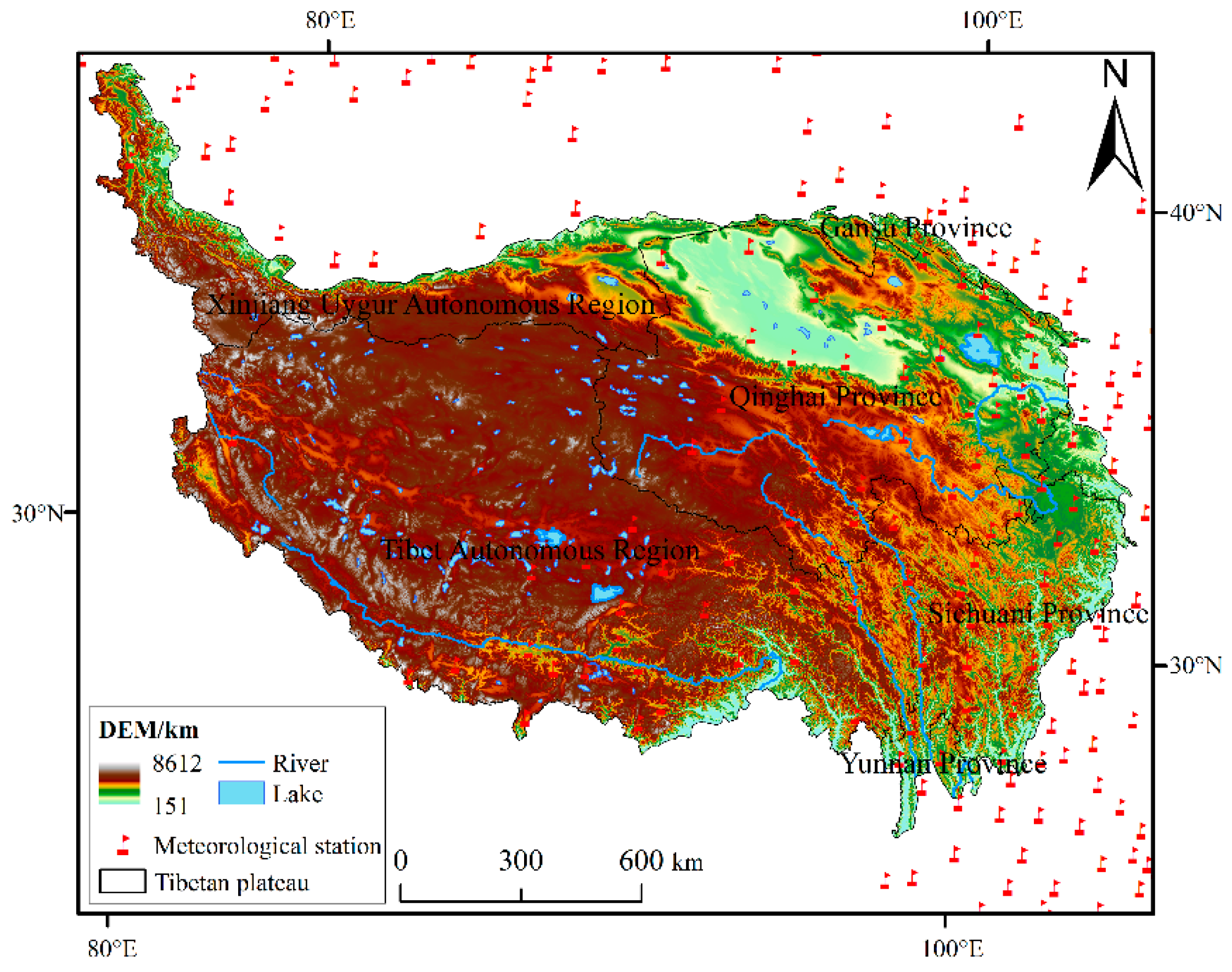

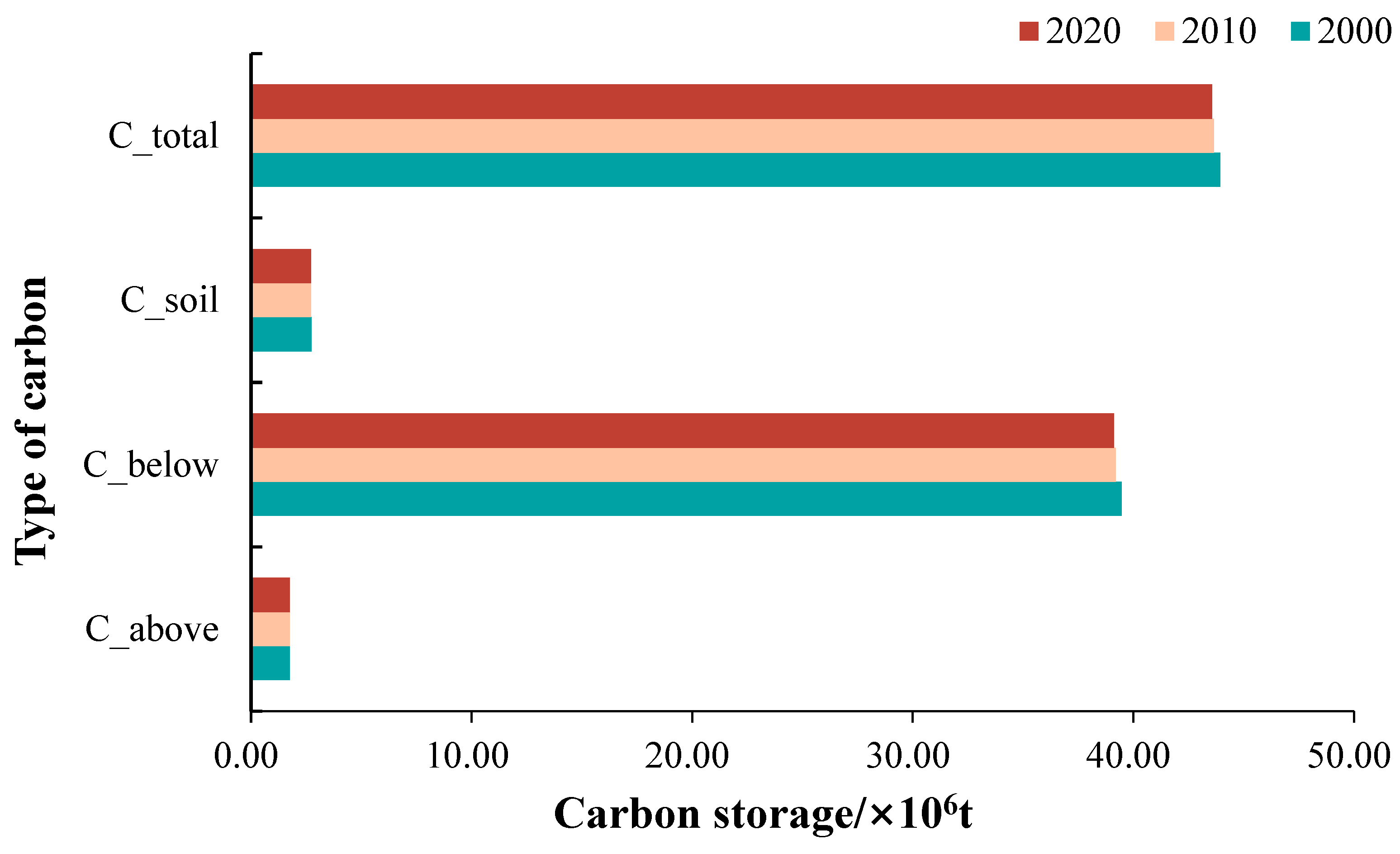
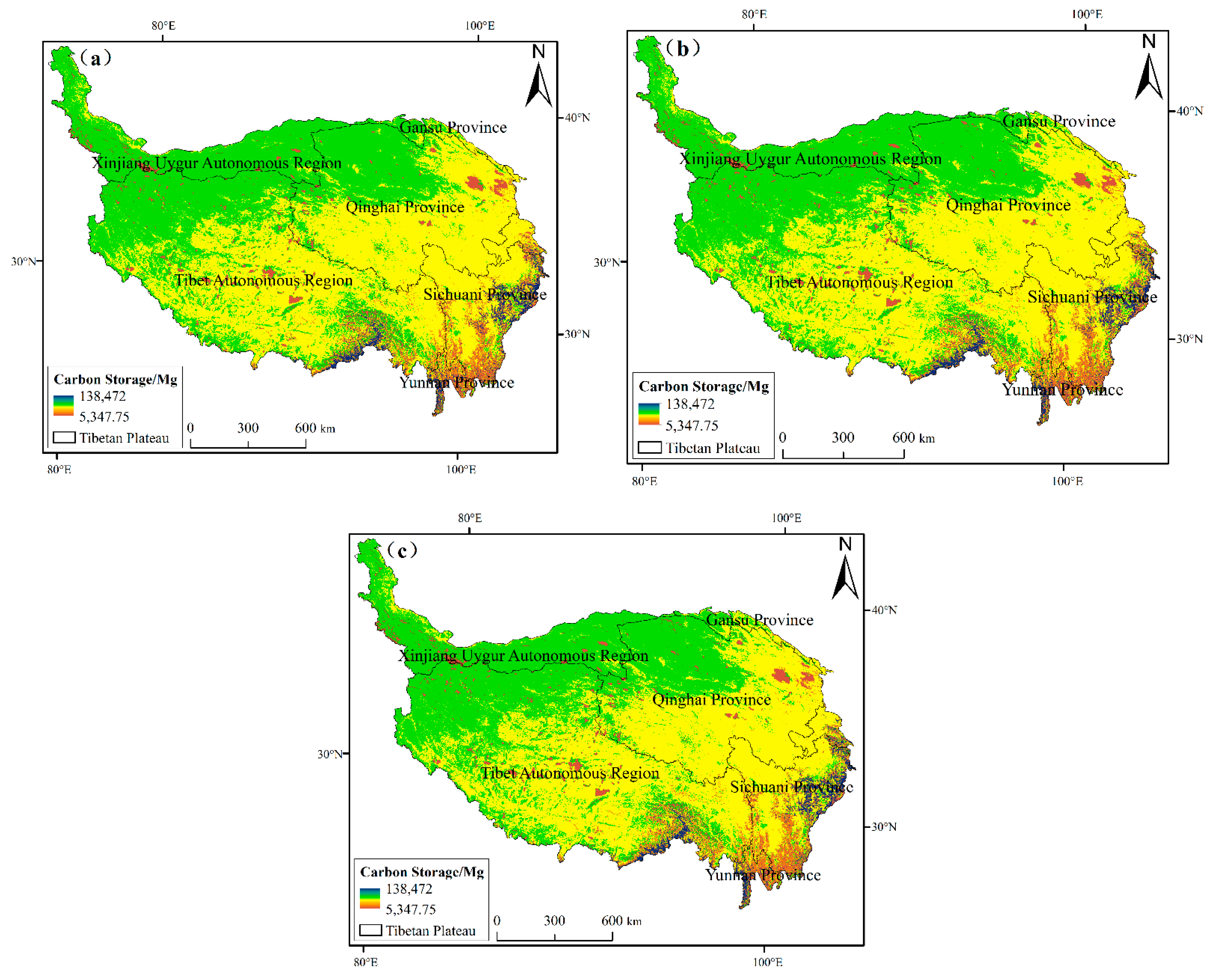

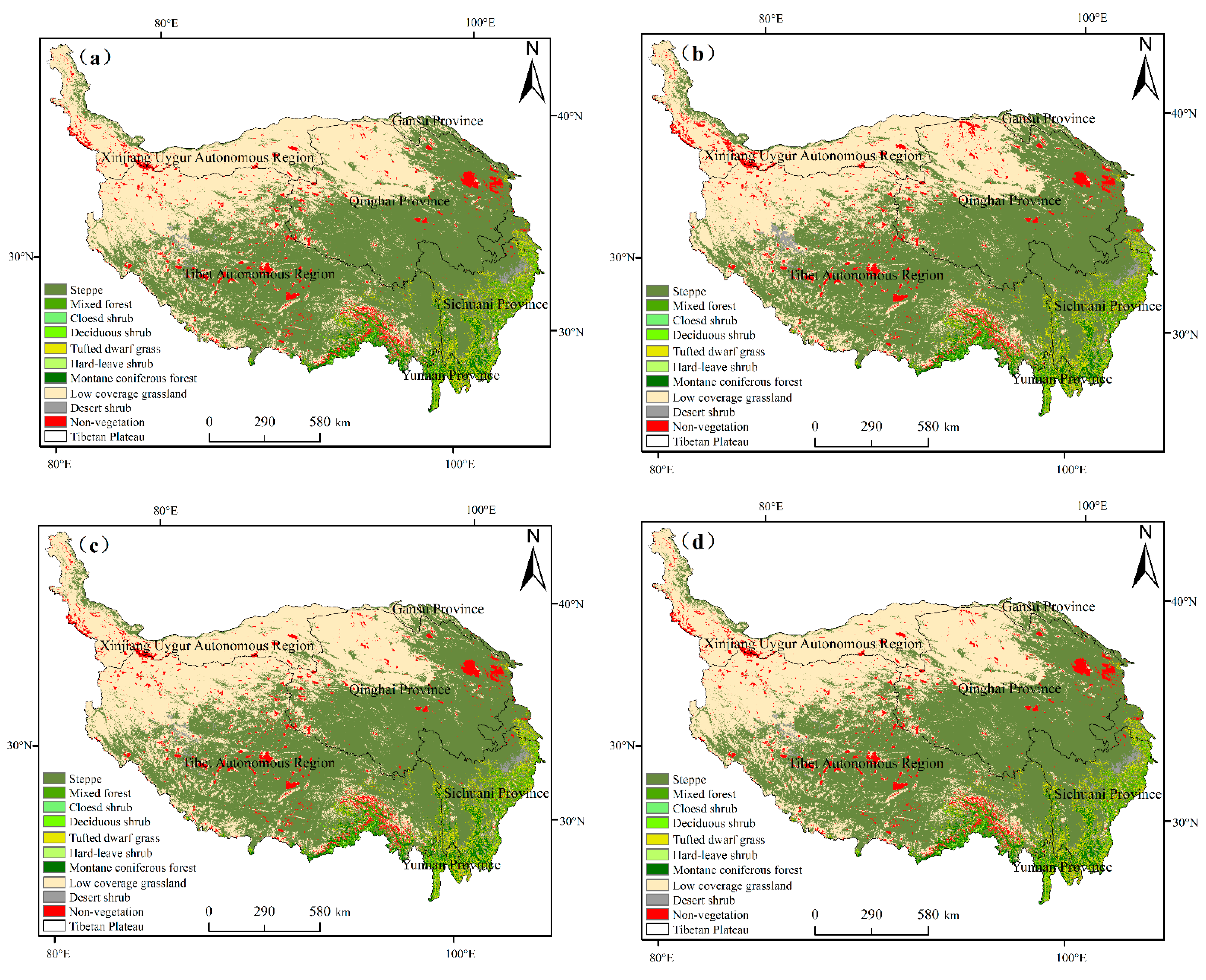

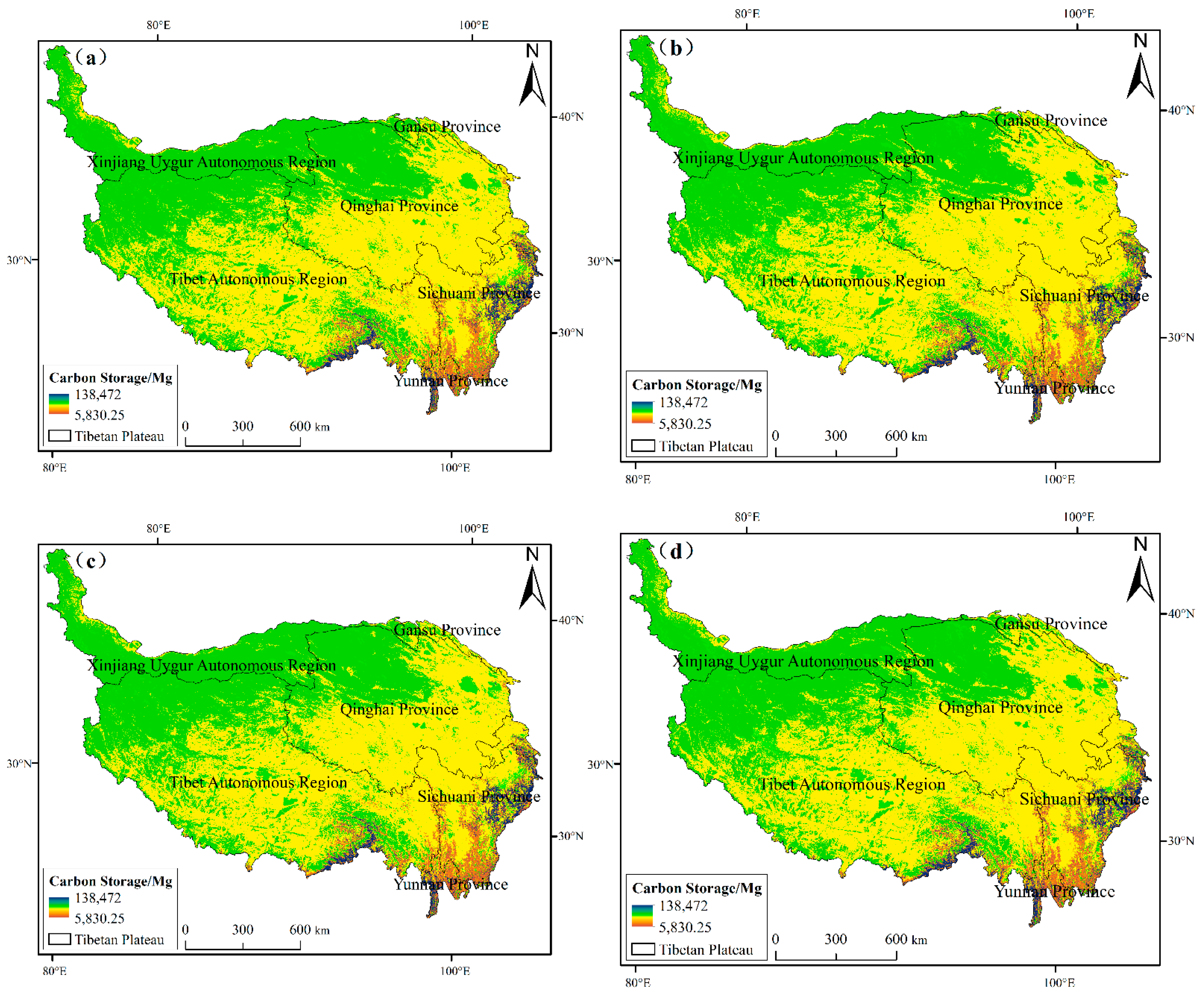


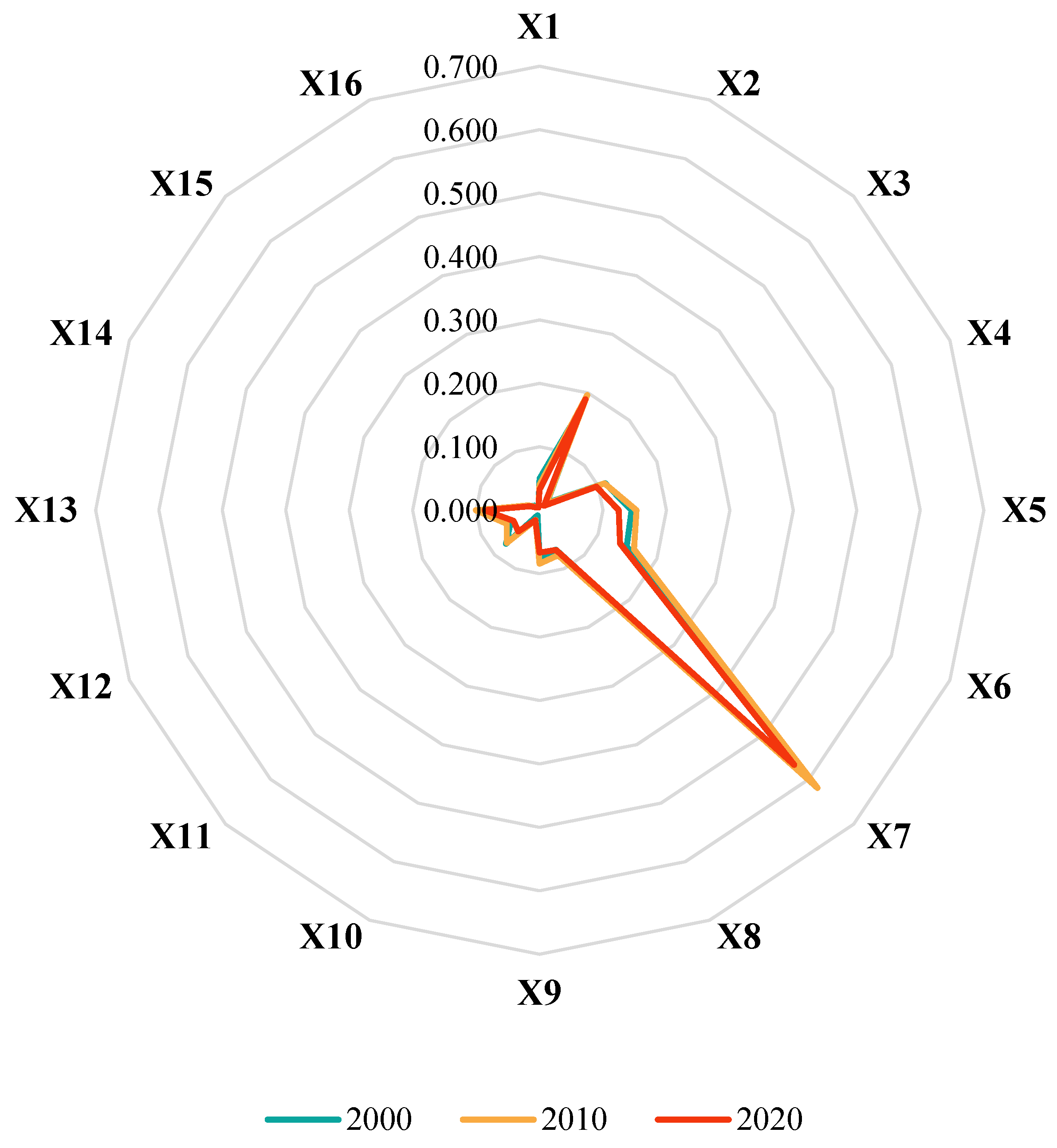
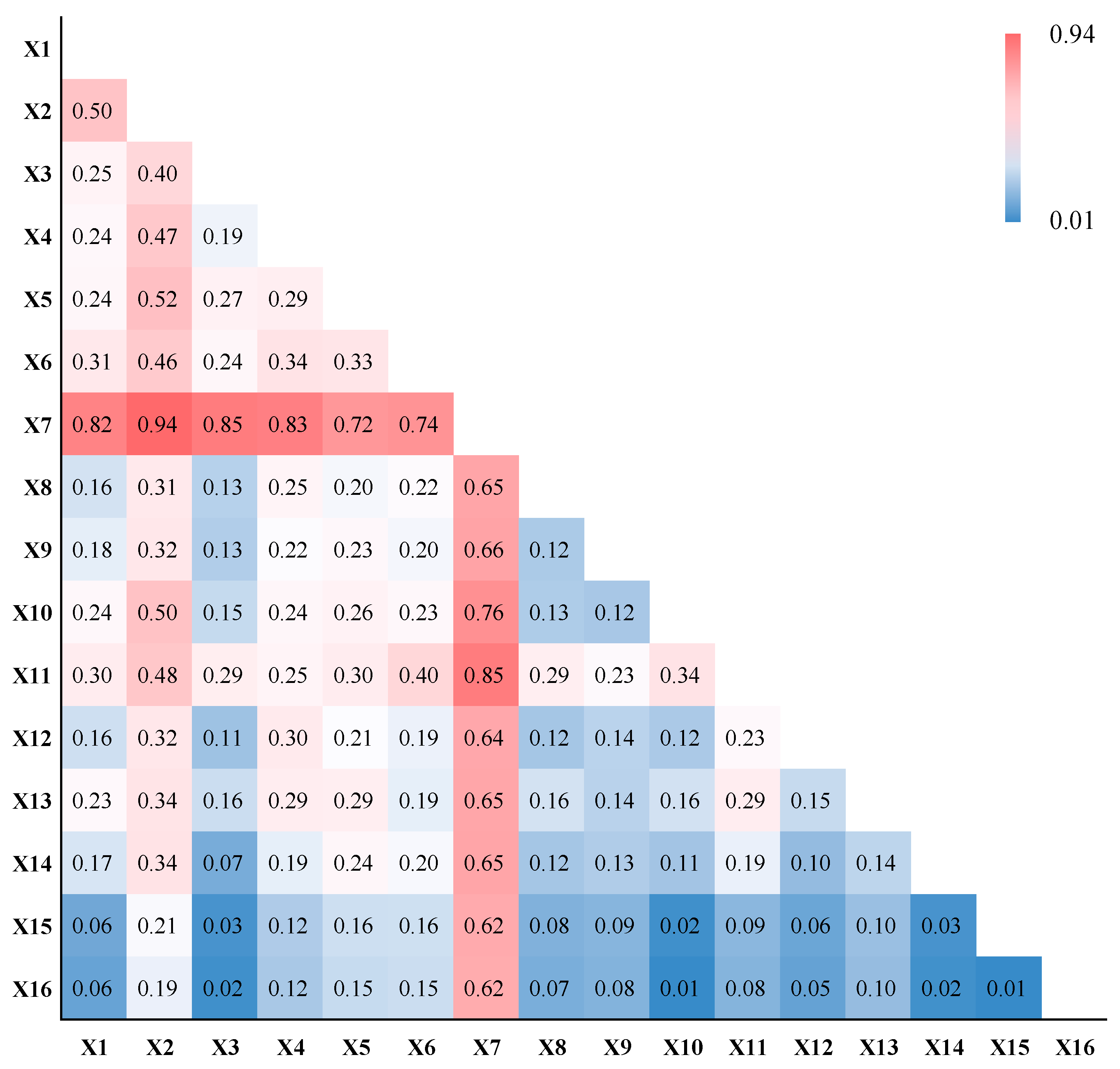
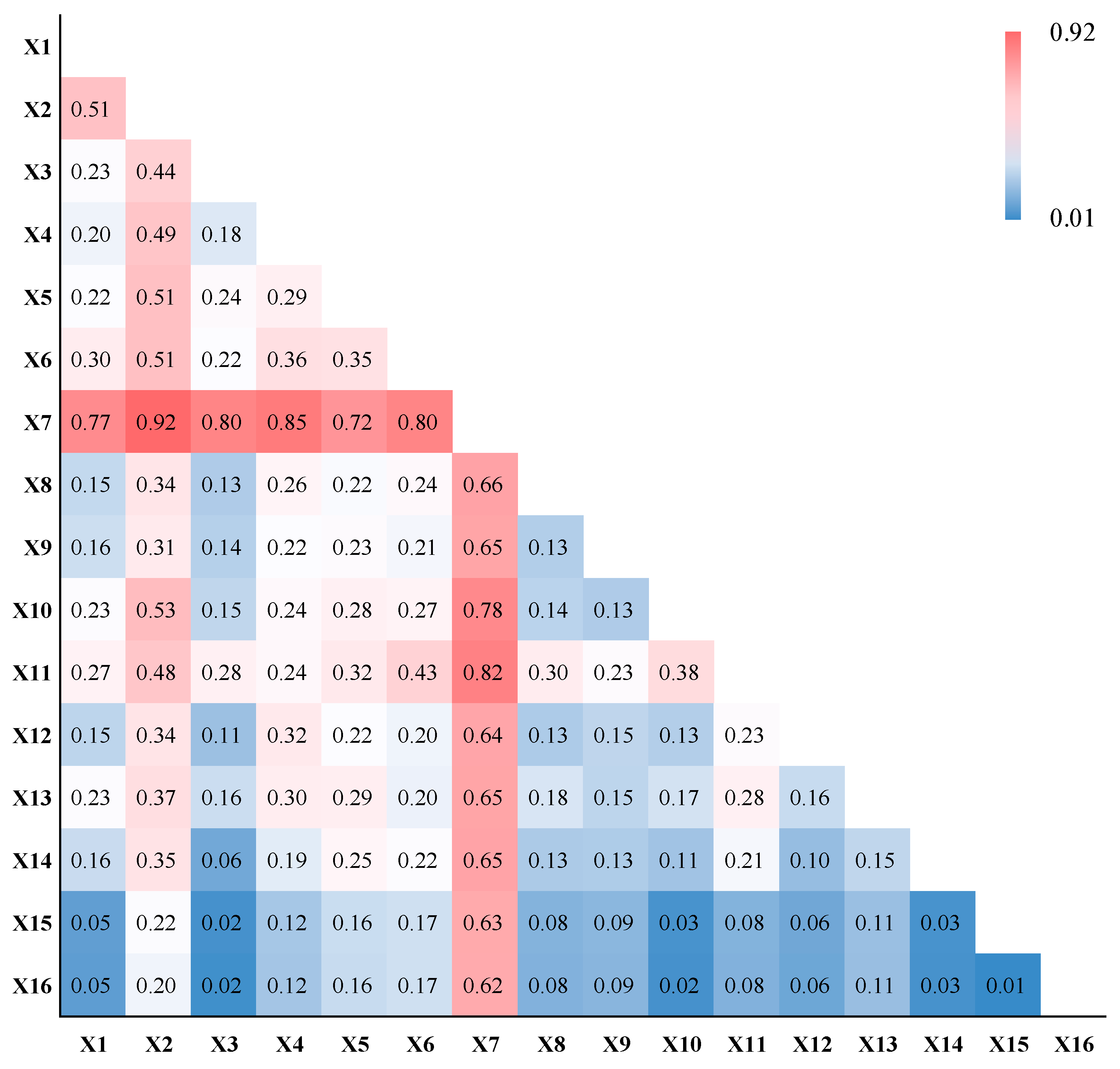

| Data Type | Number | Data Name | Resolution (m) | Data Sources | Pretreatment Process |
|---|---|---|---|---|---|
| Vegetation type data | Y | Vegetation type | 500 | United States Geological Survey (http://www.usgs.gov/ (accessed on 5 January 2023)) | Reclassify |
| Topographic Factors | X1 | Slope | 200 | Geospatial Data Cloud (https://www.gscloud.cn/ (accessed on 5 January 2023)) | Resample |
| X2 | Digital elevation model (DEM) | 200 | Resample | ||
| X3 | Aspect | 200 | Resample | ||
| Climatic factors | X4 | Temperature | 500 | The China Meteorological Data Service Center (http://www.nmic.cn/ (accessed on 5 January 2023)) | Kriging interpolation |
| X5 | Hours of sunshine | 500 | |||
| X6 | Precipitation | 500 | |||
| Other natural factors | X7 | Vegetation coverage (FVC) | 1000 | United States Geological Survey (http://www.usgs.gov/ (accessed on 5 January 2023)) | Band math, Resample |
| X8 | Distance to woodland | 500 | Resource and Environment Science and Data Center (https://www.resdc.cn/ (accessed on 4 January 2023)) | Euclidean distance | |
| X9 | Distance to river | 500 | |||
| X10 | Distance to lake | 500 | |||
| X11 | Distance to grassland | 500 | |||
| Socio-economic factor | X12 | Distance to farmland | 500 | ||
| X13 | Distance to town | 500 | National Catalogue Service for Geographic Information (https://www.webmap.cn/ (accessed on 5 January 2023)) | ||
| X14 | Distance to road | 500 | |||
| X15 | The density of Gross Domestic Product (GDP) | 1000 | Resource and Environment Science and Data Center (https://www.resdc.cn/ (accessed on 3 January 2023)) | Resample | |
| X16 | The density of population (POP) | 1000 | Resample |
| Code | Name | C_Above | C_Below | C_Soil |
|---|---|---|---|---|
| 1 | Montane coniferous forest | 72.82 | 591.89 | 34.21 |
| 2 | Hard-leaf shrub | 44.73 | 3793.83 | 67.82 |
| 3 | Deciduous shrub | 70.56 | 637.55 | 86.45 |
| 4 | Mixed forest | 188.11 | 5023.27 | 188.48 |
| 5 | Closed shrub | 170.67 | 5128.69 | 239.52 |
| 6 | Desert shrub | 57.46 | 1732.45 | 101.67 |
| 7 | Tufted dwarf grass | 17.38 | 182.65 | 33.18 |
| 8 | Steppe | 64.06 | 1323.27 | 91.67 |
| 9 | Low-coverage grassland | 74.84 | 1915.1 | 134.85 |
| 10 | Non-vegetation | 46.35 | 100.18 | 67.38 |
| Criterion | Interaction |
|---|---|
| Nonlinear weakening | |
| Single-factor nonlinear weakening | |
| Double-factor enhancement | |
| Independent | |
| Nonlinear enhancement |
| Vegetation Type | Area/km2 | Area Change and Dynamic Degree during 2000–2020 | |||
|---|---|---|---|---|---|
| 2000 | 2010 | 2020 | Area/km2 | Dynamic Degree/% | |
| Montane coniferous forest | 35,240.50 | 35,240.50 | 37,828.25 | 2587.75 | 7.34 |
| Hard-leaf shrub | 2691.00 | 2616.50 | 2713.75 | 22.75 | 0.85 |
| Deciduous shrub | 8060.75 | 7083.25 | 6265.25 | −1795.50 | −22.27 |
| Mixed forest | 45,564.25 | 44,454.25 | 45,230.00 | −334.25 | −0.73 |
| Closed shrub | 97.50 | 126.25 | 98.25 | 0.75 | 0.77 |
| Desert shrub | 15,074.75 | 18,396.50 | 24,604.00 | 9529.25 | 63.21 |
| Tufted dwarf grass | 59,419.25 | 65,213.25 | 61,984.25 | 2565.00 | 4.32 |
| Steppe | 1,313,770.75 | 1,335,069.50 | 1,329,007.25 | 15,236.50 | 1.16 |
| Low-coverage grassland | 990,668.75 | 961,804.25 | 953,370.50 | −37,298.25 | −3.76 |
| Non-vegetation | 71,033.00 | 71,616.25 | 80,519.00 | 9486.00 | 13.35 |
| 2020 | |||||||||||
|---|---|---|---|---|---|---|---|---|---|---|---|
| 1 | 2 | 3 | 4 | 5 | 6 | 7 | 8 | 9 | 10 | ||
| 2000 | 1 | -- | 5.50 | 156.75 | 2535.25 | 7.00 | 155.50 | 3651.75 | 753.75 | 3.25 | 163.50 |
| 2 | 31.75 | -- | 1.25 | 215.00 | 0.00 | 1.50 | 26.75 | 1.50 | 0.00 | 2.50 | |
| 3 | 448.50 | 47.00 | -- | 1477.00 | 1.50 | 196.25 | 1100.25 | 379.00 | 0.00 | 0.25 | |
| 4 | 4786.50 | 123.75 | 437.75 | -- | 3.00 | 99.75 | 3735.50 | 852.50 | 2.50 | 47.50 | |
| 5 | 6.25 | 0.00 | 0.25 | 1.25 | -- | 24.75 | 25.50 | 21.25 | 0.25 | 0.00 | |
| 6 | 64.25 | 9.75 | 127.75 | 79.00 | 2.25 | -- | 1531.00 | 4145.25 | 924.75 | 123.25 | |
| 7 | 4066.00 | 104.75 | 570.75 | 4838.00 | 26.00 | 2320.25 | -- | 4325.50 | 23.25 | 163.25 | |
| 8 | 486.75 | 12.25 | 547.75 | 594.00 | 40.25 | 12,579.50 | 8789.75 | -- | 33,653.00 | 3180.25 | |
| 9 | 12.75 | 0.00 | 0.25 | 0.00 | 0.25 | 1013.25 | 12.25 | 60,945.00 | -- | 14,725.25 | |
| 10 | 117.25 | 0.00 | 11.75 | 15.00 | 0.00 | 145.75 | 130.00 | 3696.25 | 4803.75 | -- | |
| Type of Change | Meaning (Mg) | Area (km2) | Proportion (%) |
|---|---|---|---|
| Severe increase | ≥70,000 | 10,102.50 | 0.40 |
| Increase | 10,000~70,000 | 101,360.25 | 3.99 |
| Stable | −10,000~10,000 | 2,351,132.75 | 92.51 |
| Decrease | −10,000~−70,000 | 69,252.25 | 2.72 |
| Severe decrease | ≤−70,000 | 9772.75 | 0.38 |
| Vegetation Type | Area of Vegetation Types in 2030/km2 | Area of Vegetation Types in 2060/km2 | ||||
|---|---|---|---|---|---|---|
| Inertia Development Scenario | Farmland Protection Scenario | Ecological Priority Development Scenario | Inertia Development Scenario | Farmland Protection Scenario | Ecological Priority Development Scenario | |
| Montane coniferous forest | 39,952.25 | 39,952.25 | 37,861.00 | 36,675.50 | 36,746.00 | 37,937.00 |
| Hard-leaf shrub | 2536.75 | 2516.75 | 2658.75 | 2637.00 | 2642.25 | 2678.00 |
| Deciduous shrub | 5798.75 | 5750.25 | 6138.00 | 5386.25 | 5412.25 | 6167.00 |
| Mixed forest | 45,629.25 | 45,629.25 | 45,629.25 | 45,266.25 | 45,266.25 | 45,266.25 |
| Closed shrub | 91.25 | 91.25 | 91.25 | 84.25 | 85.00 | 97.25 |
| Desert shrub | 28,569.00 | 28,569.00 | 28,569.00 | 32,966.50 | 32,966.50 | 25,583.75 |
| Tufted dwarf grass | 61,262.25 | 60,780.25 | 62,502.50 | 60,442.25 | 60,343.25 | 61,680.50 |
| Steppe | 1,324,129.50 | 1,324,129.50 | 1,332,418.50 | 1,359,391.75 | 1,359,391.75 | 1,359,391.75 |
| Low-coverage grassland | 945,921.00 | 945,921.00 | 945,921.00 | 903,881.50 | 903,878.00 | 924,069.00 |
| Non-vegetation | 87,730.50 | 88,281.00 | 79,831.25 | 94,889.25 | 94,889.25 | 78,750.00 |
Disclaimer/Publisher’s Note: The statements, opinions and data contained in all publications are solely those of the individual author(s) and contributor(s) and not of MDPI and/or the editor(s). MDPI and/or the editor(s) disclaim responsibility for any injury to people or property resulting from any ideas, methods, instructions or products referred to in the content. |
© 2023 by the authors. Licensee MDPI, Basel, Switzerland. This article is an open access article distributed under the terms and conditions of the Creative Commons Attribution (CC BY) license (https://creativecommons.org/licenses/by/4.0/).
Share and Cite
Zhao, H.; Guo, B.; Wang, G. Spatial–Temporal Changes and Prediction of Carbon Storage in the Tibetan Plateau Based on PLUS-InVEST Model. Forests 2023, 14, 1352. https://doi.org/10.3390/f14071352
Zhao H, Guo B, Wang G. Spatial–Temporal Changes and Prediction of Carbon Storage in the Tibetan Plateau Based on PLUS-InVEST Model. Forests. 2023; 14(7):1352. https://doi.org/10.3390/f14071352
Chicago/Turabian StyleZhao, Huihui, Bing Guo, and Guojun Wang. 2023. "Spatial–Temporal Changes and Prediction of Carbon Storage in the Tibetan Plateau Based on PLUS-InVEST Model" Forests 14, no. 7: 1352. https://doi.org/10.3390/f14071352





